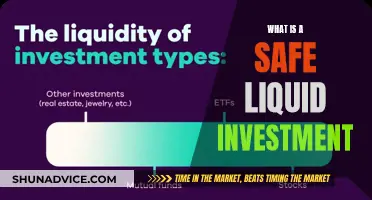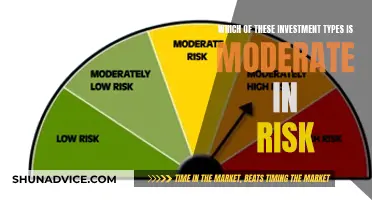
No-risk investments are those that carry a minimal risk of loss. While there is no such thing as a completely risk-free investment, certain options come with insurance or government backing, making their risk practically non-existent. These include money market accounts, online high-yield savings accounts, cash management accounts, certificates of deposit, and treasury notes, bills, and bonds. These investments are considered very safe, but their yields are typically lower, reflecting the usual trade-off between risk and return.
| Characteristics | Values |
|---|---|
| Return | Low |
| Risk | None or very low |
| Liquidity | High |
| Inflation protection | No |
What You'll Learn

Money market accounts
While money market accounts are considered low-risk, it's important to note that they are not entirely risk-free. There may be penalty fees for falling below balance and withdrawal requirements. Additionally, maintaining a large sum of money in a money market account without earning enough interest to outpace inflation could result in a loss of purchasing power over time.
Overall, money market accounts are a reliable option for those seeking a safe and stable investment with higher interest rates than traditional savings accounts. They are well-suited for individuals saving for short-term goals or looking to build an emergency fund.
Investing: A Viable Career Path?
You may want to see also

High-yield savings accounts
While high-yield savings accounts are a safe investment option, there are a few drawbacks. Interest rates are variable and can change at any time. They are also not the best way to generate long-term wealth for retirement because the yield often doesn't keep up with inflation. Additionally, most high-yield savings accounts are offered by online-only financial institutions, not those with physical locations, which may be a drawback if you prefer in-person banking.
Assessing Church Investment Risk: A Guide to Financial Stewardship
You may want to see also

Money market funds
- Certificates of deposit (CDs)
- Treasury bills (T-Bills)
- Short-term commercial paper
- Bankers' Acceptances (BA)
- Commercial paper
- Repurchase agreements (Repo)
- U.S. Treasuries
Portfolio Investments: Developing Countries' Failure
You may want to see also

Certificates of deposit (CDs)
CDs are considered a low-risk investment option. They are FDIC-insured investments that offer fixed interest rates over a set period (often six months to five years). Their returns are usually higher than savings accounts but still fixed and predictable. CDs can be well-suited for investors who don't need immediate access to their funds and are looking for relatively higher, guaranteed returns over a specific period.
CDs provide reliable, fixed-rate returns on a lump sum of money over a fixed period of time, such as 6 months, 1 year, or 5 years. You can get a traditional CD at a bank or credit union. They typically require a minimum deposit, and you'll be hit with a penalty if you pull your money out before the CD matures.
You can also get brokered CDs, which are similar to bank CDs in that they are FDIC-insured but differ in that they are issued by banks to customers of brokerage companies as securities that can be held in a brokerage account. Brokered CDs are usually issued in large amounts to the brokerage, which it then divides into smaller parts for resale.
With a brokered CD, the broker’s underlying CD purchase from the bank is insured. So, in the unlikely event that insurance is needed, it will flow from the bank to the brokerage to the investor. Brokered CDs are subject to the same FDIC limits as traditional CDs. But buying CDs through a brokerage firm can help you expand the amount of FDIC protection inside a brokerage account by buying multiple brokered CDs from different issuers.
Unlike traditional CDs, brokered CDs can be bought and sold on the secondary market before they mature. But doing so will incur trading fees, and the price you are able to receive on the secondary market may be below the price you originally paid for the CD.
If you're considering investing in CDs, it's important to keep in mind that there may be penalties for early withdrawal. Additionally, CD rates are influenced by decisions made by the Federal Reserve, so it's a good idea to stay informed about their current and future plans.
Private Equity: Majority Investment, What's Next?
You may want to see also

Treasury securities
Treasury bills mature in one year or less, notes span up to 10 years, and bonds typically mature in 20 to 30 years. When you buy any of these, you are lending money to the US government. At the end of the term, you will receive your initial investment back, known as the principal, face value, or par value, plus the interest you've earned.
The US government also offers Treasury Inflation-Protected Securities (TIPS). TIPS have a fixed interest rate, but the principal adjusts with inflation or deflation, as measured by the Consumer Price Index (CPI). While TIPS can help you hedge against inflation, their interest rate is often lower than other Treasury securities.
Although Treasury securities are considered low-risk, they do come with some risks, such as being impacted by inflation and changes in interest rates. The interest paid on Treasury securities is also fully taxable at the federal level.
NRIs: Investing in India from the US
You may want to see also
Frequently asked questions
There are no truly no-risk investments, but some are considered extremely low-risk. These include money market accounts, high-yield savings accounts, cash management accounts, certificates of deposit (CDs), and Treasury notes, bills, and bonds.
No-risk investments are ideal for those who want to preserve their capital and maintain a steady flow of interest income. They are also good for short-term savings goals and emergency funds.
No-risk investments typically offer lower returns over the long run. They may also lose purchasing power over time due to inflation.







